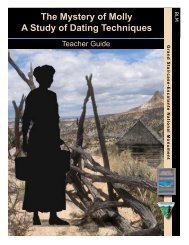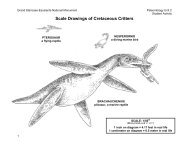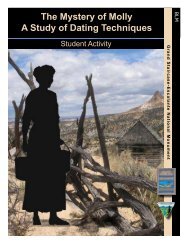Plate Tectonics and the Rock Layers of Grand ... - Gsenmschool.org
Plate Tectonics and the Rock Layers of Grand ... - Gsenmschool.org
Plate Tectonics and the Rock Layers of Grand ... - Gsenmschool.org
You also want an ePaper? Increase the reach of your titles
YUMPU automatically turns print PDFs into web optimized ePapers that Google loves.
Gr<strong>and</strong> Staircase-Escalante National Monument Geology Unit 2<br />
Student Activity<br />
XIII. Claron Formation – Tc<br />
Time formed<br />
<strong>Rock</strong><br />
Location<br />
Appearance:<br />
Special features<br />
Environment when<br />
formed<br />
Similar modern day<br />
habitats<br />
~50 mya, Cenozoic/Tertiary<br />
Limestone, s<strong>and</strong>stone, siltstone<br />
This formation is mostly in Dixie National Forest <strong>and</strong> Bryce<br />
National Park.<br />
Pale orange, yellow, pink white; 1000 to 1600 feet; wea<strong>the</strong>rs into<br />
cliffs, spires, columns <strong>and</strong> pinnacles. Forms <strong>the</strong> Pink Cliffs <strong>of</strong> <strong>the</strong><br />
Gr<strong>and</strong> Staircase.<br />
Rapid erosion forms “hoodoos,” very colorful cliffs.<br />
In a very large freshwater lake, sediments collected <strong>and</strong> consolidated<br />
to form <strong>the</strong> Claron Formation. The pink member <strong>of</strong> <strong>the</strong> Claron is<br />
predominantly river channel, flood plain, <strong>and</strong> lake deposits.<br />
A large fresh water lake with high inflow, but little outflow.<br />
Postscript<br />
Paleogene time <strong>and</strong> Neogene time deposits are scattered throughout <strong>the</strong> Monument. These<br />
materials rest on top <strong>of</strong> exposed rock strata <strong>and</strong> include:<br />
• Lava flows <strong>and</strong> cinder cones form basalt, tuff, <strong>and</strong> ash layers.<br />
• Wind blows s<strong>and</strong> into surface dunes, especially near eroding s<strong>and</strong>stone.<br />
• Water washes debris, s<strong>and</strong>, <strong>and</strong> gravel into streambeds, terraces, <strong>and</strong> floodplains.<br />
• Mass wasting creates talus slopes <strong>and</strong> rock falls.<br />
• Wet shales collapse in l<strong>and</strong>slides <strong>and</strong> slumps.<br />
• Glaciers during <strong>the</strong> Pleistocene added materials later moved by water erosion.<br />
And it Continues<br />
Monument l<strong>and</strong>s <strong>and</strong> <strong>the</strong> entire Colorado <strong>Plate</strong>au continue to rise in elevation. Tributaries to <strong>the</strong><br />
Colorado River keep wearing deeper into <strong>the</strong> canyons. Faults still move <strong>and</strong> erosion continues to<br />
form windblown <strong>and</strong> waterborne deposits. Even human activities affect <strong>the</strong> geologic face <strong>of</strong><br />
GSENM. Its story is still being written.<br />
14





